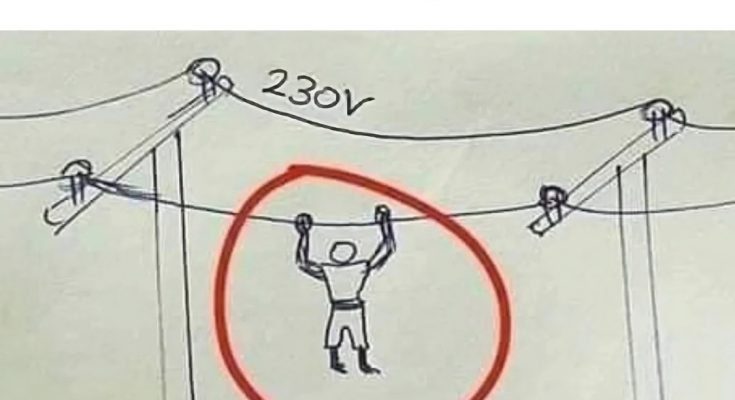Birds are frequently observed resting peacefully on electrical wires, seemingly unfazed by their surroundings. This observation prompts a thought-provoking inquiry: if an individual were to grasp a live wire with both hands, would they experience an electric shock? To comprehend this situation, it is essential to explore the principles of electricity and the specific conditions that permit safe interaction with live wires, as opposed to those that can lead to severe harm. Let us examine the scientific principles governing electric currents to uncover the realities of such scenarios.

How Electricity Flows: The Basics of Electrical Circuits
To determine whether an individual would experience shock while suspended from a live wire, it is essential to comprehend the basic principles of electricity. Electrical current circulates within circuits, originating from a power source, traversing conductors, and ultimately returning to its source. For electricity to pass through any object or individual, it must form a complete circuit, which necessitates both an entry and an exit point for the current to flow.
When a bird rests on a single electrical wire, it does not create a complete circuit, as there is no additional point of contact for the electricity to flow through. This situation protects the bird from electric shock, and a similar concept applies to a person hanging from a live wire. Nevertheless, additional factors can influence the distinction between safety and significant danger.
Will Hanging on a Live Wire Cause Electric Shock?
If an individual grips a live wire with both hands and lacks any additional point of contact—such as the ground or another wire—they may not experience an electric shock. This phenomenon occurs because, similar to a bird perched on a wire, they do not complete the electrical circuit. Consequently, the electric current continues to flow within the wire itself rather than passing through the individual’s body. In the absence of a second point of contact to create an exit path, the electricity has no incentive to deviate from its course within the wire.
In summary, by holding onto a single live wire without making contact with anything else, there is no circuit for the electricity to traverse through the body. The individual remains insulated from the current, which explains why they would not feel a shock in this specific scenario. Nevertheless, it is important to note that this does not render the situation safe in any respect.
Why Safety Risks Still Exist: Unpredictable Factors and Human Error
While the concept of hanging from a live wire may appear to be safe in theory, actual conditions present significant dangers. Even a minor error in judgment or an unintentional movement could result in accidental contact with another object—be it the ground, a tree, or an adjacent wire. The moment a second point of contact is established, a conduit for electrical current to traverse the individual’s body is formed, leading to an immediate and potentially lethal electric shock.
In scenarios where both a live wire and the ground are present, electricity travels from the high-voltage line, through the body, and into the ground. The human body, due to its conductive properties, facilitates the passage of electricity, which can lead to injuries that range from severe burns to fatal electrocution.

Why Birds Don’t Get Shocked While Perching on Wires
Birds resting on power lines serve as a clear illustration of how remaining on a single conductor can prevent electric shock. They do not complete the electrical circuit because they are not in contact with another conductive object at the same time. Additionally, the limited surface area of birds results in minimal contact with the wire, further decreasing their risk. As there is no conductive exit point, the electric current remains within the wire, effectively bypassing the bird.
Conversely, if a bird were to make contact with another wire or a grounded object while standing on a live wire, the current would pass through its body, leading to electrocution. This explains why birds are generally safe on wires but become vulnerable when wires are in close proximity or when they inadvertently touch another object that allows the electricity to complete its circuit.
Human Scenarios Where Electric Shock Risks Increase
While birds make it look easy, humans face more complex variables when near live wires. For a person, even subtle changes in position, movements, or unexpected shifts can introduce secondary points of contact. Some risky scenarios include:
- Accidentally Touching Another Wire – If a person hanging from a live wire inadvertently makes contact with another wire (either live or grounded), they would immediately form a circuit and experience an electric shock.
- Proximity to Ground or Other Objects – The closer a person is to the ground or grounded objects, the higher the chance of accidental contact, which could result in a pathway for electricity through the body.
- Conductive Materials – Wearing or carrying conductive materials, such as metallic items or damp clothing, can make a person more susceptible to shock if they get close to a secondary point of contact.

Why Trained Professionals Still Exercise Extreme Caution
Even skilled professionals, including linemen, implement comprehensive safety measures when handling electrical wires. They utilize specialized tools, wear insulated clothing, and adhere to strict protocols to prevent the creation of unintended circuit paths. Working on live wires without appropriate protective gear or a deep understanding of electrical currents poses significant risks and can result in severe injuries. Professional electricians and linemen receive extensive training to comprehend these dangers and to follow safety procedures aimed at reducing the likelihood of accidental contact with other conductive materials.
Key Takeaways: Why Staying Clear of Live Wires Is Essential
While it may be theoretically possible for an individual suspended from a single live wire to avoid electric shock, this scenario is far from safe. The potential dangers stemming from accidental contact or human mistakes significantly surpass any fleeting feeling of safety. Electricity is inherently unpredictable, and without the appropriate professional equipment, the risk of encountering live wires is not a chance worth taking. Therefore, maintaining a safe distance from live wires remains the most prudent choice.
- Uncontrolled Environment – Unlike controlled lab settings, outdoor electrical wires present multiple uncontrolled variables, such as wind, movement, or objects nearby.
- Accidental Contact Risk – Even the slightest accidental contact can create a circuit, resulting in immediate and severe consequences.
- High Voltage Danger – Electrical currents in live wires are extremely powerful, and exposure to high voltage can cause fatal injuries almost instantly.
- Lack of Protective Measures – Professionals working with live wires use specialized gear and follow strict protocols. For an unprotected individual, the risks are exponentially greater.
Conclusion: Respect Electricity, Respect Safety
Can an individual grasp a live wire without experiencing an electric shock? In theory, it is possible if one only holds onto the single wire and avoids any other points of contact. However, in practical terms, this situation is extremely hazardous due to the unpredictable nature of real-world conditions and the significant risk of unintended contact. Unlike birds, humans cannot depend on a safe experience when interacting with live wires, as even the slightest error could result in severe consequences.
The lesson to be learned? Acknowledge the dangers of electricity and prioritize safety. Whether driven by curiosity or a desire to gain a deeper understanding of electrical currents, it is crucial to remember that no theoretical knowledge justifies the risk of physical harm. Always maintain a safe distance from live wires, and if you encounter electrical tasks, it is best to leave them to trained professionals who are equipped to manage them safely.



